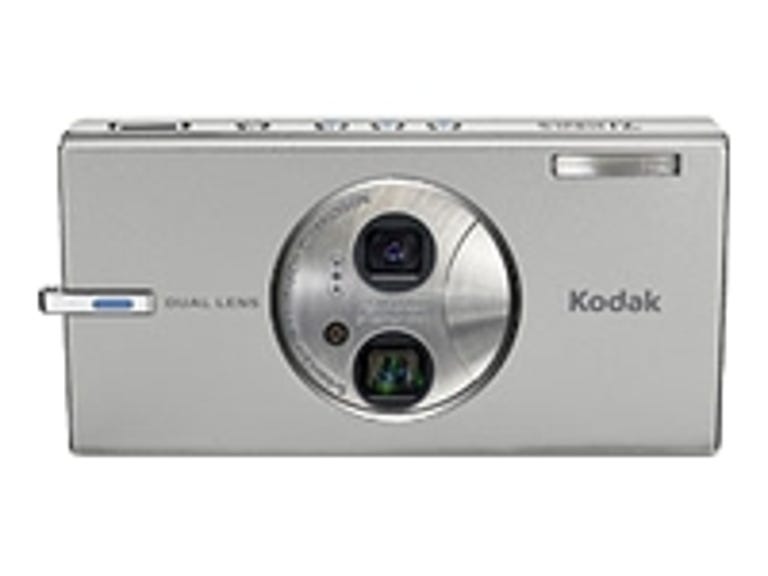 Why You Can Trust CNET
Why You Can Trust CNET Kodak EasyShare V705 review: Kodak EasyShare V705
Kodak EasyShare V705
Aside from the colors, the V705's body is almost identical to the V570's, complete with the automatic sliding lens cover emblazoned with Ultrawide and 5X. The 5X part is actually a bit of marketing hype, since it includes the gap between the 23mm lens and the start of the 3X zoom at 39mm. Kodak employs digital zoom to fill the gap, but remember, it'll rob you of a bit of resolution, though not all that much, since it's only about 1.7X worth of digital zoom. Since there are two separate lenses, there is some parallax error when switching between the two, much like when you close one of your eyes, then switch back and forth between your left and right eyes. It is most noticeable when doing close-up and macro photography.
The Good
The Bad
The Bottom Line
With snapshooters in mind, the V705's features include 22 scene modes, red-eye reduction, exposure compensation of as much as plus or minus 2EV in 0.3EV stops, 640x480-pixel video recording at 30fps, and 32MB of internal memory, so you have a little extra in case your card runs out of space. Kodak also includes in-camera editing options, including cropping, digital frames, and the company's Perfect Touch auto image fix. This displays your original image next to a processed version of it to let you decide if you like the autofixed version; you then have the choice of saving it as a new image or replacing the original. Like the V570, the V705 includes a panorama shooting mode, and since the 23mm lens is so wide, you can make a 180-degree panorama with as few as three shots.
The camera's sensitivity range exceeds that of the V570. While the auto ISO feature goes only from ISO 50 through ISO 200, you can manually select from ISO 50 to as high as ISO 1,000.
While the V705 doesn't come with a dock, it does come with a custom insert for use with a dock, and it's compatible with Kodak's EasyShare Photo Frame Dock 2 and Camera Dock Series 3, as well as their current Printer Docks. Since it doesn't come with a dock, Kodak includes a small plug, similar in size to a travel cell phone plug, which fits a small hole on the right side of the camera to let you charge the 720mAh rechargeable lithium-ion battery.
In our lab tests, the Kodak EasyShare V705 took a while to get going but gave adequately speedy performance after that. The time from pressing the power button to capturing its first image measured 3.6 seconds and time between subsequent shots was 1.2 seconds without flash, and 2.1 seconds with flash turned on. Shutter lag was barely there, measuring 0.3 second in our high-contrast test and 0.6 second in low-contrast. In continuous-shooting mode, we got seven VGA-size JPEGs in 3 seconds for about 2.3fps and seven 7.1-megapixel JPEGs in 3.4 seconds for about 2.1fps.
Image quality from the V705 is decent for a camera of its class. As usual with Kodak, colors looked very accurate and were well saturated. Though while the camera is capable of capturing an admirable amount of detail, we did see some JPEG artifacts in the form of jaggy diagonal lines and curves as well as other off-color speckles along edges of high contrast.
Also, there was more noise than we would've expected at lower ISOs. At ISO 50, noise is almost nonexistent, but even at ISO 100 it begins to become visible, mostly in darker colors and shadows. At ISO 200, it becomes slightly more noticeable and seems to exacerbate the JPEG artifacting. At ISO 400, noise becomes very noticeable and robs images of significant amounts of detail. The face of the dark, plush ape in our test scene became an indistinct, dark blob, while you can clearly see the ape's eyes at ISO 50. ISO 800 eats up tons of detail, blanketing the image in a sea of off-color pixels and mottled color. Image quality at ISO 1,000 was similar to that of ISO 800, but with slightly more off-color noise, in addition to more noise overall. Though images at these top ISO settings are useful to capture an image you might not otherwise be able to get, you probably want to stay below ISO 800 if you plan to print the images at larger than 4x6 inches.
The Kodak EasyShare V705 is, without a doubt, a snapshooter's camera. With its fast performance and decent feature set, lots of casual shooters will probably like it. The one problem is that the dual-lens/dual-sensor design comes with a price tag that makes this camera compete with cameras such as Sony's Cyber Shot DSC-T9, which has one fewer megapixel but offers slightly less noise at comparable ISOs. The Sony doesn't offer the V705's ultrawide lens, but its 3X optical zoom is similar to the V705's zoom lens. Canon's PowerShot SD630, another 6-megapixel with speedy performance, can be found for about the same price as the V705, it didn't exhibit the JPEG artifacts we saw in this Kodak, and it has equivalent, if not less, noise than the V705. Again, if you value the wide angle of the extra lens, you'll probably want to stick with the Kodak EasyShare V705.
(Shorter bars indicate better performance)
| Typical shot-to-shot time | Time to first shot | Shutter lag (typical) |
(Longer bars indicate better performance)
| Typical continuous-shooting speed |
